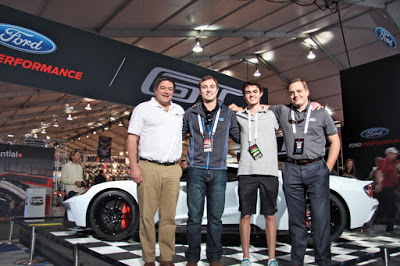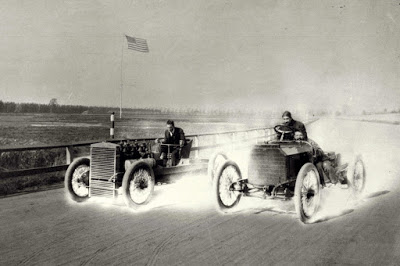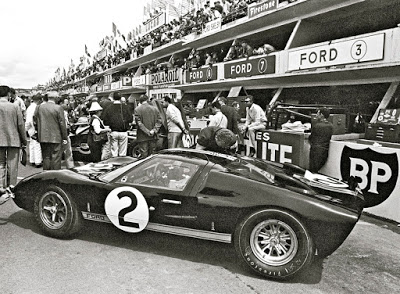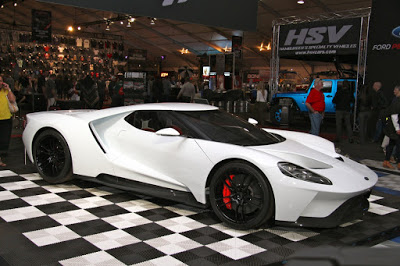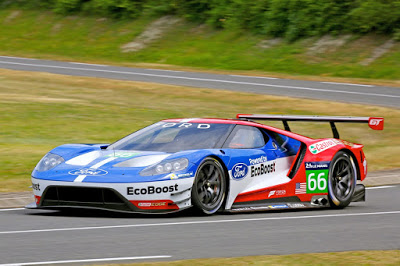Top, Ford GT. Above, L to R: Jim Owens, Matt Sylvester, Focus RS, Assistant Marketing Manager, Alex Pepe and Tyler Weiland, TimePiece PR & Marketing, the person who made this interview possible.
Recently, I had the opportunity to sit down with the marketing manager for Ford’s Performance vehicles. Barrett-Jackson Scottsdale was our rendezvous point largely due to the focus of Ford’s annual showcase this year – ’17 GT. This year was quite special, as both the ‘17 Ford GT and ‘16 Ford Focus RS were displayed. Eventually, I was escorted outside and into Ford’s hospitality center, a rather luxurious RV. After several minutes of exchanging pleasantries and shaking hands, I sat down with Jim.
AP: What impact does racing have on Ford Motor Company?
JO: We started racing in 1901, and everywhere through the decades, forgetting the 1970s. We’ve been involved in racing and performance from the 1920s through the 1960s, and the 1980s and 1990s. So, that’s where we came from. Why do we do it?
There are three things basically; the first is the engineering prowess. When you are working on the Focus RS and the torque vectoring and all-wheel drive systems, you are learning things. Those engineers will actually go out into the production world… and take what they’ve learned and apply it to normal cars and trucks that are built for the road.
Number two, the technologies and innovations. We are trying things within the Ford Performance community that eventually will trickle down to normal production cars… It’s like a test hotspot.
Finally, it is our corporate varsity sport. The products that we build for competition are directly related to products we produce for the mass marketplace. Ford is the automotive version of great brands that you might see showcased in the Australian Open: Spalding, Wilson or Prince. We are the mechanism of competition!
AP: A common theme in today’s Supercars is making the car do much of the work for the driver. Traction control, complex differentials and torque vectoring systems are making performance driving more accessible to the average Joe. What was Ford’s approach on drivability with the new GT?
JO: Today in golf, you have these giant TaylorMade oversized drivers that are bigger than my bag used to be! I am a (bad) golfer, but I have fun playing. I can hit a ball with one of those new drivers 270 yards straight down the fairway and my swing looks like my body has some sort of structural damage! When Tiger Woods or Phil Mickelson uses that same driver, they can hit the ball 400 yards dead straight, over and over again. That technology they put into those drivers makes a (bad) golfer feel really good and do things he otherwise couldn’t do. And, it makes a professional, that much better. I will say the same things about the technology that we are putting into cars today.
.
AP: So it complements the driver, regardless of ability?
JO: It complements the driver regardless of skill level, yes. It will allow you to do things that you normally wouldn’t be able to do. Take the new Focus RS. I can manually adjust the dampers and change the suspension in any driving mode I choose, or I could select one of the four presets, like Drift mode. Would you be able to drift a Focus RS without Drift mode? Maybe… if you’re a really good driver. But could you drift it in Drift mode? Absolutely.
AP: The Ferrari 488 GTB uses a twin-turbo 3.9L V8, that produces over 650 horsepower. The Ford GT uses the all-new twin-turbo 3.6L V6 EcoBoost, with a projected output well over 600 horsepower. Besides the obvious reduction in weight, what led Ford to go with the V6?
JO: This car is an excellent example of form follows function. When we designed this GT, I initially thought we would aim for huge displacement figures with a big-block V8! I was later surprised to hear we would be working with the EcoBoost V6. It saved weight, but it also saved on “package tray” size. That change in package tray size allows the air between the flying buttresses to move through more freely, which changes the center of pressure and allows you to go 200+ miles an hour down the Mulsanne straight. That’s why we chose the V6 route.
We kept asking ourselves what would make the car perform better on a racetrack? That EcoBoost V6 has the reliability, the torque, and the 600-plus horsepower. We aren’t going to say 601, only that it’s well over 600!
AP: At one point, I asked if Ford would have liked to take the GT to the ‘Ring?
JO: Hell yeah! However, now timed lapping is almost impossible at Nurburgring since they’ve imposed several speed-restricted sections on the track, following a number of unfortunate crashes involving spectators.
AP: Before my time with Jim ended, I made sure to ask for details on the application process for purchasing a production Ford GT. For starters, they haven’t yet finished the forms. Even if you can’t afford the new GT, you can still fill out a form. But you’ll need plenty of time as I’m told it will be lengthy. If however, you are one of the few who can shell out the necessary funds for this car, it still doesn’t mean you will get one in your garage anytime soon.
The new GT will have very limited production, estimated at 250 cars per year for worldwide distribution. Complicating the buying process more is what Ford wants you to own before they’ll even consider your application.
I asked Jim what sort of cars Ford would look for before letting you buy a GT?
JO: They’re looking for buyers who already own cars that played important roles in Ford Motor Company’s racing/performance history. Some examples include the ‘68 Shelby Mustang GT500 KR, Mk I – MK IV GT40, and the first generation 2005-2006 Ford GT.
Photos: Alex Pepe, Ford Motor Co.
For more information about Ford’s new GT, please visit https://www.ford.com/performance/gt/


